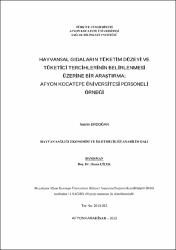Hayvansal Gıdaların Tüketim Düzeyi Ve Tüketici Tercihlerinin Belirlenmesi Üzerine Bir Araştırma :Afyon Kocatepe Üniversitesi Personeli Örneği
Künye
Erdoğan, Nesrin. Hayvansal Gıdaların Tüketim Düzeyi Ve Tüketici Tercihlerinin Belirlenmesi Üzerine Bir Araştırma: Afyon Kocatepe Üniversitesi Personeli Örneği. Afyonkarahisar: Afyon Kocatepe Üniversitesi, 2013.Özet
Bu araştırma, Afyon Kocatepe Üniversitesinde görevli personelin hayvansal gıda tüketim düzeyi ve tüketim tercihlerinin belirlenmesi amacıyla yapılmıştır.
Araştırma için gerekli olan verilerin elde edilmesinde yüz yüze anket yöntemi uygulanmıştır. Araştırmaya dahil edilecek katılımcıların belirlenmesinde tabakalı örnekleme yöntemi kullanılmış ve toplam 348 kişiyle yüz yüze anket yapılmıştır. Çalışma, Haziran 2012-Şubat 2013 arasında yürütülmüştür.
Hayvansal gıda tüketimi ile gelir düzeyi, toplam gıda harcaması ile gelir düzeyi ve gıda harcaması içerisinde hayvansal ürünlerin payı ile gelir düzeyi arasındaki ilişkiler ki-kare (χ2) testi ile incelenmiştir.
Araştırma sonucunda, hanelerdeki ortalama birey sayısı 3,36 ± 1,26, ortalama çalışan birey sayısı 1,64 ± 0,57, aylık ortalama gelir 3000 ± 1009,7 TL ve aylık ortalama gıda harcaması 715 ± 342,7 TL olarak hesaplanmıştır. Aylık gıda harcaması içerisinde hayvansal ürünlerin aldığı ortalama pay %22,4 bulunmuştur.
İçme sütü ve süt ürünlerinde yıllık kişi başı ortalama tüketimlerin içme sütünde 29 ± 12,45 kg, peynirde 5,7 ± 2,33 kg, yoğurtta 10,1 ± 3,35 kg, ayranda 5,4 ± 3,07 kg, tereyağında 1,75 ± 0,83 kg ve süt kaymağında 1,1 ± 0,45 kg olduğu tahmin edilmiştir.
Katılımcı hanelerinde kişi başı yıllık ortalama kırmızı et tüketimi 18,84 ± 6,28 kg, ortalama kanatlı eti tüketimi 15,12 ± 4,32 kg ve ortalama balık eti tüketimi de 9,42 ± 3,73 kg tahmin edilmiştir. Sucuk dışında diğer et ürünlerinde önemli bir tüketim değerine rastlanmamıştır.Hanelerin yıllık kişi başı ortalama yumurta tüketimi 29 ± 45,24 adet, bal tüketimi ise ortalama 1,7 ± 0,94 kg tahmin edilmiştir.
Ki-kare testi (χ2) sonuçlarına göre, hanelerdeki gelir artışı ile gıda harcaması (p<0,001), bu harcamanın içerisinde hayvansal ürünlerin payı (p<0,05), içme sütü (p<0,05), yoğurt (p<0,05), sığır-dana eti (p<0,05), balık eti (p<0,01), yumurta (p<0,001) ve bal tüketimleri (p<0,05) arasındaki ilişkiler anlamlı bulunmuştur.
Sonuç olarak eğitim ve gelir seviyesi itibariyle toplumda belirli bir konumda yer alan üniversite personelinin hayvansal gıda tüketim düzeyi ve tüketici tercihlerinin anlamlı farklılıklar ortaya koyduğu belirlenmiştir The aims of this study is to identify the consumption of animal products and consumer preferences among academic or non-academic staff at Afyon Kocatepe University.
Data were collected by face-to-face interview technique. Stratified sampling methods were used in order to determine the participants employed in this study, and 348 participants were interviewed. The study was carried out between June 2012 and February 2013.
Chi-square (χ2) test was used to analyze the relationship among animal products the levels of consumption-income, total food expenditure-income, and the share of animal products out of total food expenditure-income level.
In this study, the average number of the individuals in a family were 3.36 ± 1.26, the average number of working individuals in the 1.64 ± 0.57, the average income in the family 3000 ± 1009.7 Turkish Liras, and the average food expenditure were 715 ± 342.7 Turkish Liras. It was found that the average share of animal products as a monthly food expenditure was 22.4%.
The annual consumption of drinking milk per capita was 29 ± 12.45 kg whereas the annual consumption of milk products per capita 5.7 ± 2.33 kg cheese, 10.1 ± 3.35 kg yoghurt, 5.4 ± 3.07 kg ayran, 1.75 ± 0.83 kg natural butter and 1.1 ± 0.45 kg butterfat.
The annual consumption of meat products per capita was predicted as 18.84 ± 6.28 kg for meat, 15.12 ± 4.32 kg for chicken meat and 9.42 ± 3.73 kg for fish meatA significant consumption could not be found for other meat products except for sausage.
The annual consumption of eggs and honey per capita were 129 ± 45.24 piece and 1.7 ± 0.94 kg respectively.
According to chi-square (χ2) results, the increase in the income of individuals are significantly related with food consumption (p<0,001), the share of animal products out of total food expenditure (p<0,05), drinking milk consumption (p<0,05), yoghurt consumption (p<0,05), meat products consumption (p<0,05), fish meat consumption (p<0,01), egg consumption (p<0,001) and honey consumption (p<0,05).
The present results indicate that the animal products consumption and consumer preferences among the university staff who have a higher status in the society in terms of their higher educational level and income level reveals significant differences.
Bağlantı
http://hdl.handle.net/11630/2142Koleksiyonlar
- Yüksek Lisans Tezleri [636]



















